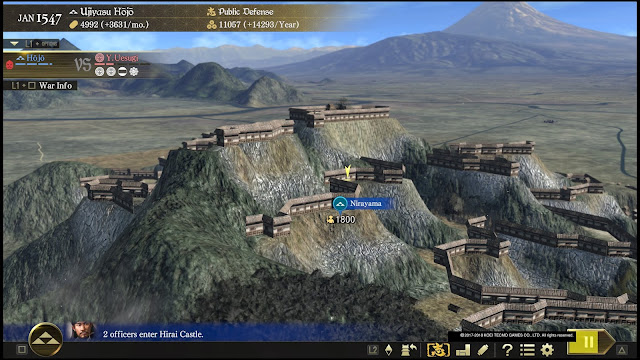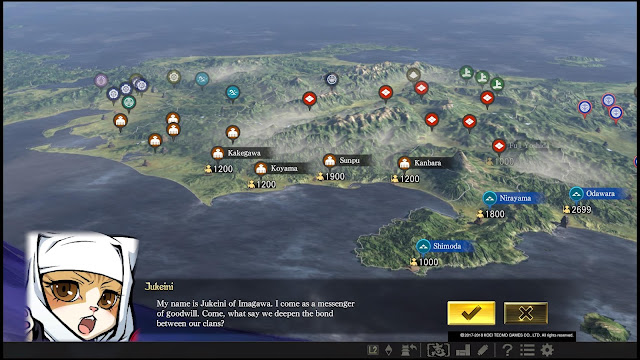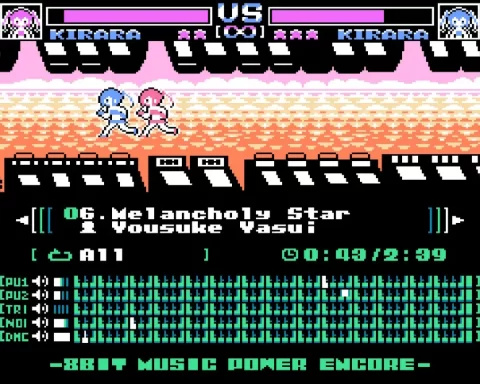Review by Matt S.
For a series that has been kicking around since the original NES, Nobunaga’s Ambition has been truly impressive in how it has always managed to find ways to keep reinventing itself for those fans that have been with it from the start. Nobunaga’s Ambition: Taishi is the third title in the franchise on the PlayStation 4, and it is indeed very distinct from the other two. I’d also say it’s the best of them.
Taishi’s focus is a little more heavily on the personalities of the era than the other Nobunaga’s Ambition titles, giving it a greater sense of story and character, to go with the relatively dry treatment of the historical period and the battles. As with any of the Nobunaga’s Ambition series, you can choose any clan that was active in the period, and there are several different scenarios that will kick the campaign off at different points in time, with the historical strengths of each warlord adequately portrayed at that point in time.
From there of course history is in the palm of your hands and you can completely reverse the fortunes of any warlord that you like. I’ve always liked turning the Hojo clan of Odawara into the dominant power in Japan, for example. Not the easiest job when historically they were a clan on the wane in the later years of the period, but that’s part of the thrill of it all: seeing if you can reverse history. What’s different about Taishi is that you’ll need to be constantly aware of the goals and personalities of your head warlord (daimyo) and clan. Just as historically not every leader had the same ambitions, so too has this game really steeled its focus on making sure that each clan has its own unique “personality traits,” and you’re rewarded for sticking to them, without necessarily being bounded by them. In other words, if you choose a pacifist clan to control, you’ll be rewarded for making friendly with the nearby clans, but you also won’t be punished by decided to add some land to your territory.
The result of this focus on clans and leadership personalities is that Nobunaga’s Ambition is more easily relatable for players who perhaps don’t have an encyclopedic understanding of the era and personalities. If you’re only casually acquainted with Samurai Warriors, for example, you’re probably not going to know many of the names beyond Nobunaga Oda, Iyeasu Tokugawa and one or two mavericks like Masamune Date and Motonari Mori. If even those names – western education systems are not great about educating people about Japanese history. Nor is our culture particularly inclined to produce movies or TV shows about them. But with Nobunaga’s Ambition: Taishi, that doesn’t necessarily matter, because you’ll be learning plenty about even the minor heroes as you play.
The ability to turn on the “cat” versions of the characters helps make things even more accessible. By default the character portraits that are displayed throughout the game are of “realistic” character portraits. They’re not perfect attempts at depicting each character, but they’re essentially appropriate to the person and his approximate appearance. However, turn the cat portraits on, and each major character in the game has his or her portrait replaced with a cat taken from Koei’s popular (in Japan) Nobunyaga’s Ambition franchise. This provides a purely aesthetic change, but once again, helps to make the relatively try and textbook presentation of Japan, its battles, and its history as something appealing to new players.
What is less accessible, and would be impossible to change without fundamentally changing the game itself, is those first few hours of play. Nobunaga’s Ambition is a series of hardcore 4X strategy games, where you need to juggle military conquest with diplomacy, economics, and the development of your region. This means page after page after page of data, and menu screens featuring dozens upon dozens of different options. Taishi includes a comprehensive tutorial that will walk you through everything you need to think about, and how to manage each part of your empire, but even with that, unless you’re a veteran to serious strategy games, this game will likely still come across as overwhelming.
But the reason I say the game has “no choice” but to do this is that its very identity is wrapped up in its complex systems. If you didn’t need to think about carefully stroking alliances so you can marry your kids off and keep the family line strong, if you didn’t need to strategically locate fortresses and ninja villages around to deal with possible invasions, and if you didn’t need to do whatever you could to build dams up so that come the wet season your crops and provisions weren’t devastated by floods, Nobunaga’s Ambition would cease to be Nobunaga’s Ambition.
As with the best strategy games there’s always going to be so many more things that you want to do than you’ll have the money and human resources to achieve. As such, the secret to success in the game is making good use of limited resources – particularly if you’re playing as one of the weaker daimyos. Building alliances with powerful neighbours is important, but so too is building complex trade networks to protect yourself from one of your main trade hubs from being monopolised by an opponent. Unfortunately, you’re limited in how many trade routes and negotiations you can enter into each “month” (turn), so you’ll need to be selective. Likewise, recruiting soldiers to fight your wars is always a delicate balancing act between leaving enough people on your farms to continue to produce the provisions you need to run your territories, while making sure you are at least keeping pace with the military development of your rivals.
Nobunaga’s Ambition: Taishi does a really good job of highlighting just how complex warfare and politics was back during the Sengoku era. This wasn’t a case of one or two sides with overwhelming might crashing into one another. This was a an era in which a rich tapestry of warlords scrambled to consolidate power, but consistently managed to keep one another in check. It was only in the later half that dominant powers started to emerge. This works to the benefit of a strategy game because it really does encourage smarter play than simply building up bigger forces than what the others had. Finding alliances and creating goodwill with neighbours was important. Concentrating on defensive play was equally important; army sizes through most of the Sengoku era were small, so a well-developed ninja farm that could devastate provisions and whittle away enemy forces was almost as valuable as having a large army… and a well-maintained fortress on the border with a hostile enemy was definitely worthwhile.
Despite the complexity, this is a game that really needs to be played on the highest difficulty. The biggest flaw that Taishi has is that it’s a little too easy to game the AI. In fairness, it’s almost impossible to create something of this complexity and expect the AI to be able to think like a human, but on lower difficulties the AI is far too generous in negotiations, far too meek to threaten military action, and far too inefficient in developing up its territories. The easiest way to push through the lower difficulty levels is simply run around each of the neighbours that you didn’t want to conquer, marry your officers off to their maidens (or vice versa), and forge alliances that they’d then never consider breaking. Not once will they turn you down. Ramp up the difficulty setting and the AI still lacks creativity, but it certainly stops being a pushover.
One area which some might see as a step back for the series is the tactical combat. As with all Nobunaga’s Ambition games, you can choose to either leave the AI to control the battles for you (not recommended if the two sides are close in power, but useful if you’ve got an overwhelming advantage), or you can take control yourself. If you take control yourself you’ll find the battles no longer play out in real time, as with the previous Nobunaga’s Ambition on PS4. Instead there’s a blend of real time and turn based action which allows you to prepare manoeuvrs at the start of each “turn” before then watching how they play out.
There is a wide range of tactical options available to players, all modelled on the tactics that the warlords of the era utilised (successfully or unsuccessfully). Having the turn-based planning of combat also works to Nobunaga’s Ambition’s strengths as a fundamentally thoughtful experience. Despite this I just know that people are going to thumb their nose at the “step back” to turn-based action in this game.
Nobunaga’s Ambition is much more true to what the Sengoku period was all about than Koei’s other famous series set in the era, Samurai Warriors. Don’t get me wrong, Samurai Warriors is one hell of a good time and I’d be surprised if I ever grow tired of that series, but the Sengoku period wasn’t one of endless conflict. It was a time of civil unrest and war, yes, but it was also a time of political maneuvering and personalities, and where I feel Samurai Warriors struggles to properly reflect the importance of daimyos such as Masamune Date and Chosokabe Motochika (who were known as well as, if not more than, for the work they did domestically and politically than their conquests), Nobunaga’s Ambition gives them the prominence they are due.
This is the kind of game I can sit down to and play for an entire evening without realising how much time was slipping. It’s always “just one more turn,” or “just one more battle”, and even after all these years of playing Koei’s strategy and action games set through the Sengoku period, and reading books about it, I’m always impressed that Koei Tecmo manages to teach me something new each time it releases something in the franchise.
Just bring it to the Nintendo Switch now, please. There’s a Nobunaga’s Ambition on there in Japan already, but I want this exact game, in English, so I can play on the go.
– Matt S.
Editor-in-Chief
Find me on Twitter: @digitallydownld
 |
| Please Support Me On Patreon!
|











